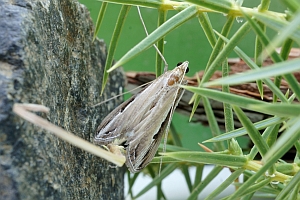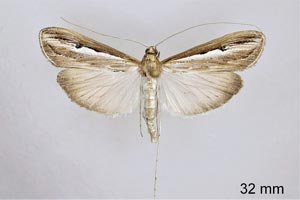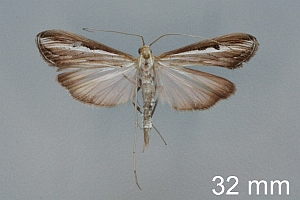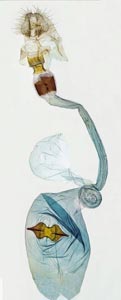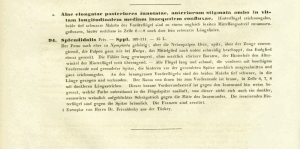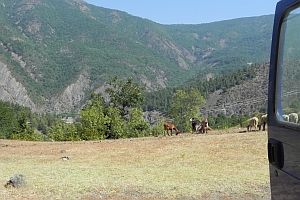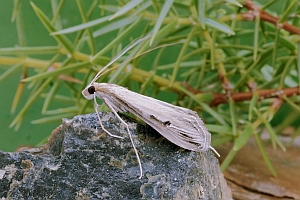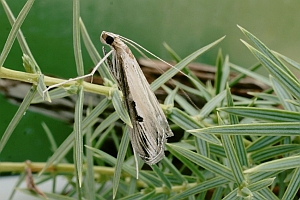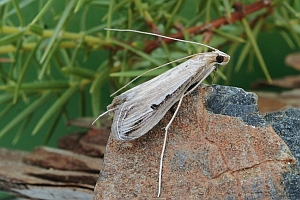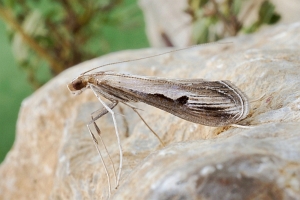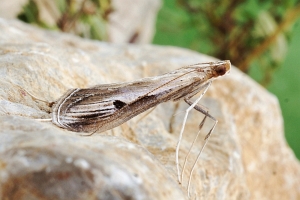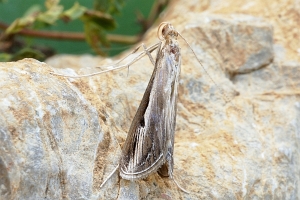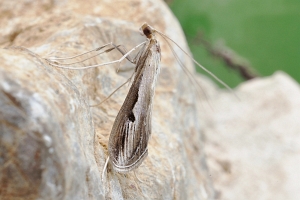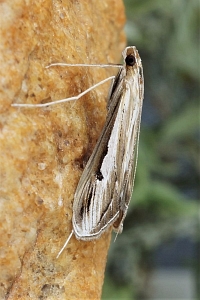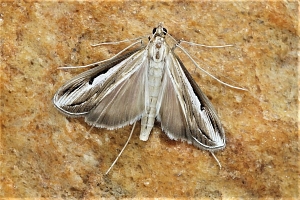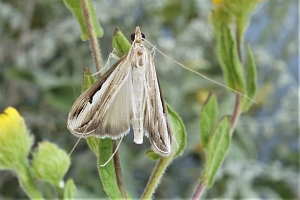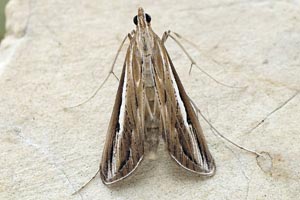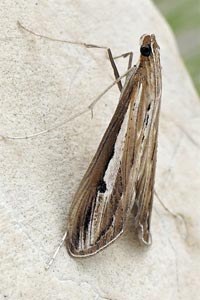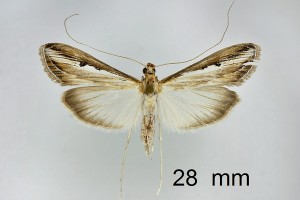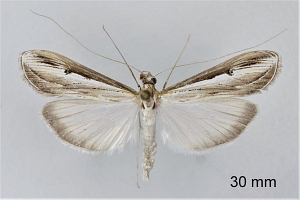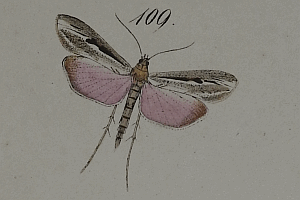

 +16Kontinente:EUAS
+16Kontinente:EUAS1. Lebendfotos
1.1. Falter
2. Diagnose
2.1. Weibchen
2.2. Geschlecht nicht bestimmt
2.3. Genitalien
2.3.1. Weibchen
2.4. Erstbeschreibung
Im Folgejahr dazu erschienene Abbildung
3. Biologie
3.1. Habitat
3.2. Nahrung der Raupe
- [Apocynaceae:] Periploca graeca (Griechische Baumschlinge)
Yepishin et al. (2021: 380) berichten zur Art in der Ukraine: "One larva was collected 17.VII.2020 on Periploca graeca L. (Figs 11–12) from vicinity of Vylkove city (Fig. 13). On 18.VII.2020 larva was pupated, and the adult emerged on 27.VII.2020." Raupe im Freiland und (offenes) Larvalhabitat werden abgebildet. Die giftige Nahrungspflanze ist im östlichen Mittelmeerraum weit verbreitet, sowohl in Auwäldern als auch in typischen Macchien.
(Autor: Erwin Rennwald)
4. Weitere Informationen
4.1. Andere Kombinationen
- Botys splendidalis Herrich-Schäffer, [1848] [Originalkombination]
4.2. Faunistik
In einem Artikel von Josep Joaquim Pérez De-Gregorio & Emili Requena Miret (MICROLEPIDÒPTERS (PYRALIDAE, CRAMBIDAE) NOUS O INTERESSANTS PER A LA FAUNA CATALANA I IBEROBALEAR (VIII) ).
Ses. Entom. ICHN-SCL, 13-14 (2003-2007): 91-106 Barcelona, 2008
ist folgendes vermerkt:
„Euclasta varii Popescu-Gorj & Constantinescu, 1973 (= perisalis Vives Moreno, 1980) (fig. 2c) Microlepidòpter subtropical, descrit de Malawi i d’altres localitats etiòpiques, la distribució septentrional del qual arriba fins al nord de l’Àfrica (Marroc, Algèria, Tunísia) i la Mediterrània occidental i oriental (Iemen, Aràbia) (Popescu-Gorj & Constantinescu, 1973). Ha estat citada de diverses localitats del sud d’Europa: cap de Gata (Almeria, Andalusia, Espanya) (Vives Moreno), les illes Balears (sense concretar l’indret) i l’illa de Malta (Sammut, 2005). Al sud d’Europa i al Magrib, sembla volar en dues generacions, entre els mesos de maig-juny i d’agost-octubre. A la península Ibèrica figura esmentada del cap de Gata (Almeria), segons una sèrie de 7 ex. recollits la nit del 22.VIII.1979 (Vives Moreno, 1980). Tant aquest autor com Popescu-Gorj & Constantinescu, (1973) figuren les estructures genitals, però no l’adult, referint el seu aspecte extern al de la veïna espècie E. splendidalis (Herrich-Schäffer, 1848), descrita de Turquia i que viu al sud-est d’Europa i l’Àsia Menor. Les citacions de E. splendidalis (Herrich-Schäffer, 1848) del Marroc (Rungs, 1979) corresponen a Euclasta varii.“
Daraus folgt, dass die Tiere aus Spanien und Marokko Euclasta varii und Tiere aus der Türkei E. splendidalis zuzuordnen sind.
(Autor: Michel Kettner)
4.3. Publikationsjahr der Erstbeschreibung
Wir folgen den Datierungs-Angaben von Heppner (1982) und von Hemming (1937: 587).
(Autor: Jürgen Rodeland)
4.4. Literatur
- Hemming, F. (1937): A bibliographical and systematic account of the entomological works of Jacob Hübner and of the supplements thereto by Carl Geyer[,] Gottfried Franz von Frölich and Gottlieb August Wilhelm Herrich-Schäffer. Volume 1: i-xxxiv, 1-605. London (Royal Entomological Society of London).
- Heppner, J. B. (1982): Dates of selected Lepidoptera literature for the western hemisphere fauna. — Journal of the Lepidopterologists' Society 36 (2): 87-111.
- Erstbeschreibung: Herrich-Schäffer, G. A. W. („1849“) [1847-1855]: Systematische Bearbeitung der Schmetterlinge von Europa, zugleich als Text, Revision und Supplement zu Jakob Hübner's Sammlung europäischer Schmetterlinge. Vierter Band. Die Zünsler und Wickler: 1-288, Index 1-48, Pyralidides pl. 1-23, Tortricides pl. 1-59. Regensburg (G. J. Manz).
- Yepishin, V., Khalaim, Y., Budashkin, Y., Zhakov, O., Mushynsky, V. & S. Novytsky (2021): New records of pyraloid moths (Lepidoptera: Pyraloidea) from different regions of Ukraine. - Zootaxa, 5023 (3): 366–388. DOI: 10.11646/ZOOTAXA.5023.3.3.
















